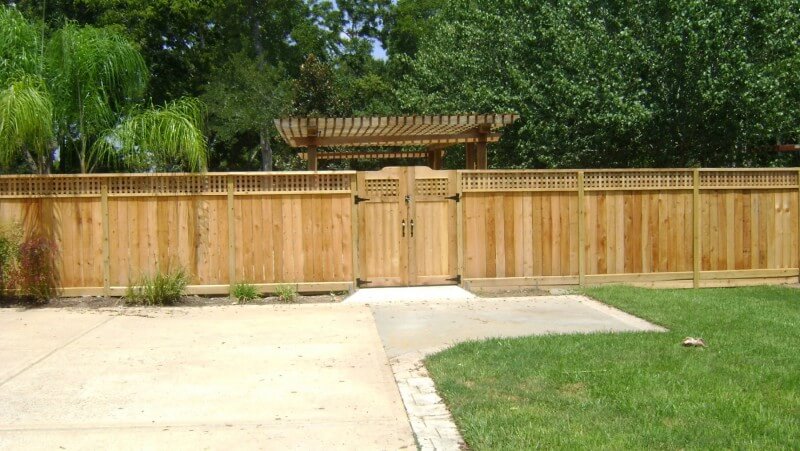Wood Privacy Fence Design Options for Your Backyard Oasis
When it comes to wood privacy fences, there are several design options to choose from. These include different styles of pickets or panels, such as board-on-board or shadowbox designs, as well as various fence heights and finishes. Additionally, you can customize your wood privacy fence with decorative elements like lattice tops or post caps. Explore our website for more detailed information and inspiration on the design options available for wood privacy fences.

Different Styles of Wood Privacy Fences
Wooden privacy fences are an excellent way to create privacy and add security to your backyard. However, the best part about wood fences is that they can be customized to fit any style or design preference. When choosing a style for your fence, consider the level of privacy you require, the layout of your yard, and your home’s architectural style.
Traditional Picket Fences
Traditional picket fences are classic wooden fences consisting of vertical boards with pointed tops attached to horizontal rails. These open-style wooden fences add an aesthetic appeal resulting in a charming look especially when combined with gardens and flowers. A low picket fence creates a border around your yard defining its edges, while a tall picket fence offers partial privacy in addition to keeping pets and children safely enclosed.
Picket fences are ideal for traditional colonial-style homes but also complement contemporary architecture when combined with clean-cut garden landscaping designs. The white color variant made from cedarwood creates a refined appearance by blending well with the dominant green color of plants.
Another great advantage of picket fences is their flexibility in terms of dimension sizes. You can adjust the distance between each board cluster choice depending on the emphasis you aim at each section of your garden’s borders — closer spacing gives more emphasis on bringing together a feeling of coziness and intimacy, whereas wider spaced options stress openness and humility.
For homeowners looking for a classic American fence type adding some resemblance to early revolutionary times, traditional picket fencing is always noteworthy for stunning aesthetics.
Horizontal and Vertical Panel Fences
Traditional picket fencing remains one of the most popular fence options because reasons cited previously lend themselves beautifully to many different home styles. Whether it’s adding charm to historic cottages or curb appeal to newer builds, this versatile fence style fits any budget and project size.
While these wooden slats might look simple in design, they come with various customizable options like varying heights, widths, and slat spacing. The smaller widths cater to a more refined and polished aesthetic, whereas the wider gaps offer more openness and airflow. Picket fences are generally shorter in height than other fence styles, making them perfect for front yard placement, as well as areas where you want to enjoy the view while sitting.
Bear in mind that wooden picket fences can increase your curb appeal and home value. A white or natural cedar stained picket fence makes a lovely addition to any yard and requires minimal maintenance, typically just a coat of top-quality paint or stain every few years to maintain its pristine appearance.
Picture this: It’s an idyllic sunny day out, and you step outside to tend your garden beds only to find curious neighborhood children playing football and trampling over your beautiful flower bed. Instead of yelling at them endlessly, let traditional picket fencing assist you in creating a border between your greenery and any unwanted disturbances.
Whether it’s small-scale picket fences around your flower beds or larger privacy fences maximizing safety and providing complete seclusion from prying eyes, our specialists guarantee competitive prices with unrivaled customer service that will ensure your satisfaction.
Lattice Panel Fences
Horizontal and vertical panel wood privacy fences are both excellent options for customers looking to achieve different aesthetics in their backyard oasis.
Horizontal panel wood privacy fences feature boards arranged side by side horizontally, creating a modern or rustic look, depending on the finished appearance chosen. These styles convey a sense of spaciousness and openness; perfect for those looking to increase airflow into their backyard. Vertical panel wood privacy fences, on the other hand, have a more classical look with boards aligned vertically. This orientation visually reduces the height of the fence and creates privacy while adding some natural mystique to your outdoor living space.
For instance, suppose you desire to keep things traditional in the backyard; in that case, vertical panels are an excellent choice as this style aligns more closely with conventional wood fencing. Conversely, going horizontal can add an element of modern flair to any backyard design concept.
When selecting between horizontal and vertical panel wood privacy fences —our expert teams assess each aspect of your property carefully. From there, we offer guidance on which option would best suit your home and its existing architecture.
Components of a Wood Privacy Fence
Lattice panel wood privacy fences are a great combination of classic charm and practical functionality for your backyard oasis. A lattice is created by weaving long, thin cedar planks together diagonally. This results in a beautiful interlaced and criss-crossed pattern that adds an element of “wow” factor.
If you’re looking for elegance and sophistication, lattice panels are an ideal solution as they create softer lines than most solid panels commonly used for many wood privacy fence styles while still providing levels of security and shelter from outside elements.
For instance, suppose you’ve invested heavily in your garden landscape, with special attention given to every detail such as garden ornaments or fixtures like colorful plants or hanging flowers, etc. In that case, lattice panels are the perfect complement to elevate your space’s beauty further.
Some people might be inclined to avoid lattice fence panels due to perceived fragility or lack of durability. However, this is not the case as these panels can withstand much more than individuals imagine.
Think about it like wearing a beautiful piece of lace clothing – you might believe lace to be delicate and easy to ruin, but with proper care and handling, the fabric will endure plenty of wear and tear in its lifespan.
Our team at Texas Fence understands every homeowner has different requirements and tastes when it comes to their backyard oasis. We work closely with each client to establish what they’re attempting to achieve, then build and construct wood privacy fences according to their needs while elevating property values and overall aesthetics in the process.
Additional Wood Panels and Rails
A wood privacy fence is a classic and timeless addition to any backyard oasis that can provide both seclusion and security, making it an appealing option for homeowners. However, not all wood fences are created equal. It’s essential to understand the components of a wood privacy fence and the design options available to ensure that you end up with the perfect balance of functionality and aesthetics.
Fence Posts
Before diving into design options, it’s crucial to understand what makes up a standard wood privacy fence.
- Fence Panels – The primary element of a wooden privacy fence comprises panels designed to conceal your backyard from public view.
- Fence Posts – The posts anchor the panels into place and support them, providing structural stability.
- Rails – These horizontal supports stretch across the posts at the top, bottom, and middle portions of the panel to connect to them and provide additional structure.
The quality of these components will significantly impact the lifespan and durability of your wood fence’s effectiveness in safeguarding your home. Therefore, it’s essential to invest in high-quality materials for longevity.
Personalizing Your Wood Privacy Fence
Fence posts hold up the structure of a wood privacy fence, so it’s essential to invest in durable and robust materials. You have several options when it comes to fence posts, each with its advantages and drawbacks.
Think of your fence post as the foundation for your fence – just as you wouldn’t build a house on a weak foundation, you shouldn’t compromise with less sturdy posts.
One popular choice is treated pine, which is affordable and resistant to rot, insects, and decay. But for added strength and durability, you might opt for cedar or redwood instead. These hardwoods offer natural resistance to rot and are less likely to warp or crack over time.
Metal posts can also be an option if you’re looking for maximum durability. Steel or aluminum posts are strong and long-lasting, but they don’t blend in well with the natural look of wooden fences. Matching brackets can help mitigate this issue.
Fence post depth should also be considered when choosing posts for your installation. Experts recommend that proper post holes should account for approximately one-third of the total length of the pole underground. Proper depth ensures stability and makes your fence more secure during harsh weather conditions.
When planning to install your fence posts, measure them twice and dig once! Ensure that ready-mix concrete is used instead of quick-drying concrete mixtures to increase post stability.
Finishing Touches for Wood Privacy Fences
If you want more significant seclusion or simply want to add some curb appeal, additional customization options are available through varying types of additional panels or rails designs.
Adding Lattice Panels
Lattice panels refer to decorative additions that can be added on top of standard panels, using various patterns such as crisscrossing diamonds or rectangles. Not only does this add some artistry elements, but it allows filtered sunlight in & out while maintaining full privacy.
Incorporating Post Caps
Post caps lock onto the top ends of fence posts adding a finishing touch to your wood fence design by giving an aesthetic value while protecting posts from damage caused by natural elements including rain.
Beveled Rail Design
Instead of flat 2×4 rails, a beveled rail adds more complexity by sloping the rail on either side. This small difference goes a long way in terms of adding some interest and texture to the overall design of your fence.
By adding a lattice panel above the primary panels, you can create accent pieces that break up what might feel like a plain wall. Strategically placed post caps easily make your fence look more custom-designed and unique. The beveled rails offer a finer level of detail and can tie-in with other decorative elements around your backyard.
Maintaining Your Wood Privacy Fence
Your privacy fence doesn’t need to be bland; there are various ways to personalize it with different designs, colors, or styles. Here are some tips:
Firstly, consider incorporating lattice panels or other decorative features like iron inserts that add visual interest while still providing privacy protection.
You can also choose from different wood styles such as traditional dog-eared or board-n-batten patterns. Horizontal slat fencing brings a contemporary-style privacy barrier that looks sleek yet stylish.
But, while there are numerous designs that look impressive, remember that the purpose of a privacy fence is to offer security and privacy. Ornate and intricate designs compromised on functions might be detrimental to what you might want from your fence.








